Management Accounting in Zylla Company: Costing and Planning
VerifiedAdded on 2024/05/20
|27
|5296
|202
Report
AI Summary
This report delves into management accounting principles within the context of Zylla Company, focusing on the replacement of their current system. It highlights the importance of management accounting, detailing its role in improving quality, reducing costs, and facilitating effective decision-making through techniques like ABC and target costing. The report covers costing reports, operational and cash reports, departmental-wise reports, and appraisal reports, emphasizing their significance in analyzing costs and operational performance. It also explores price optimization, job costing, inventory management, and cost accounting as key elements for financial sustainability. Furthermore, the document discusses marginal and absorption costing techniques, budgetary control, and their impact on organizational success. Desklib offers a platform for students to access similar solved assignments and past papers.
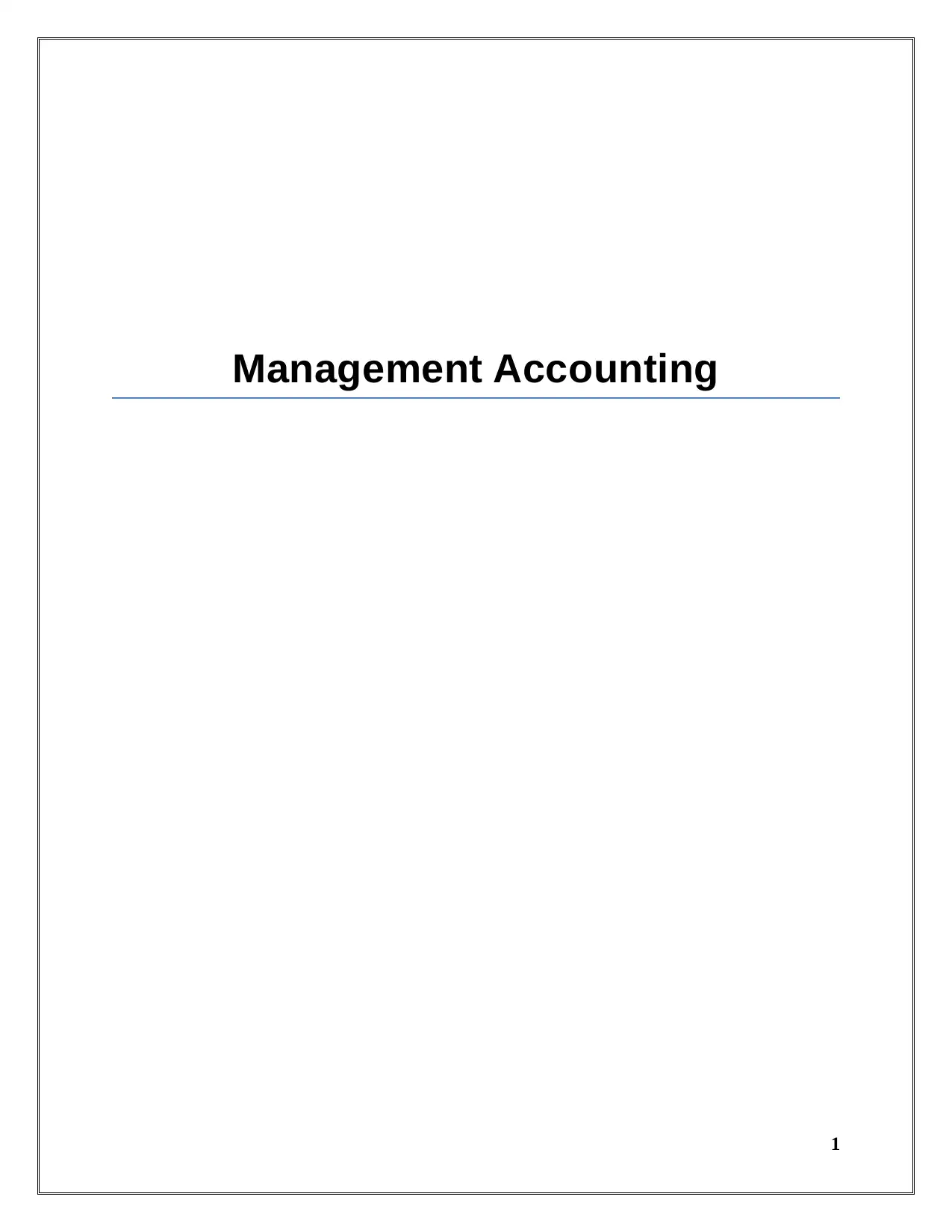
Management Accounting
1
1
Paraphrase This Document
Need a fresh take? Get an instant paraphrase of this document with our AI Paraphraser
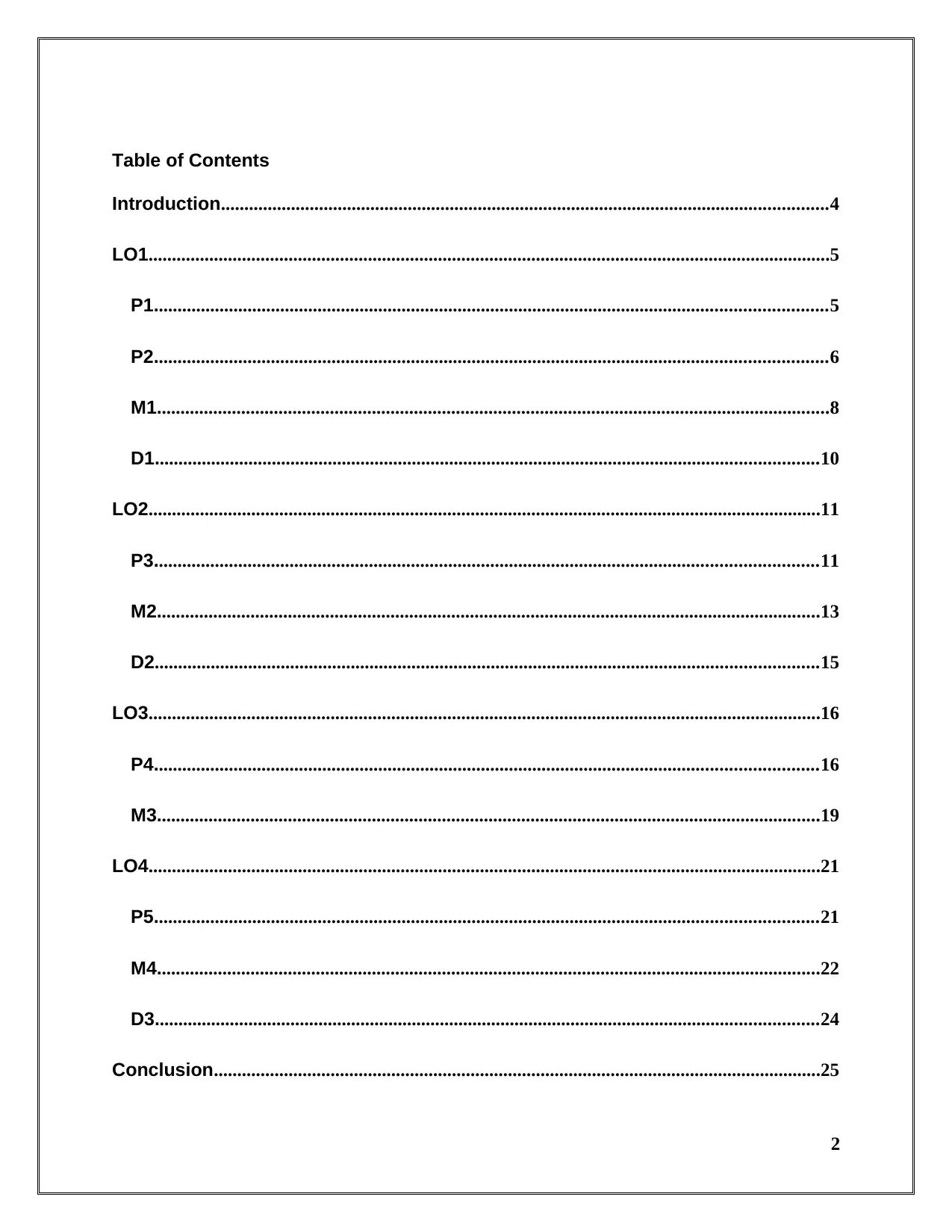
Table of Contents
Introduction..................................................................................................................................4
LO1..................................................................................................................................................5
P1................................................................................................................................................5
P2................................................................................................................................................6
M1................................................................................................................................................8
D1..............................................................................................................................................10
LO2................................................................................................................................................11
P3..............................................................................................................................................11
M2..............................................................................................................................................13
D2..............................................................................................................................................15
LO3................................................................................................................................................16
P4..............................................................................................................................................16
M3..............................................................................................................................................19
LO4................................................................................................................................................21
P5..............................................................................................................................................21
M4..............................................................................................................................................22
D3..............................................................................................................................................24
Conclusion..................................................................................................................................25
2
Introduction..................................................................................................................................4
LO1..................................................................................................................................................5
P1................................................................................................................................................5
P2................................................................................................................................................6
M1................................................................................................................................................8
D1..............................................................................................................................................10
LO2................................................................................................................................................11
P3..............................................................................................................................................11
M2..............................................................................................................................................13
D2..............................................................................................................................................15
LO3................................................................................................................................................16
P4..............................................................................................................................................16
M3..............................................................................................................................................19
LO4................................................................................................................................................21
P5..............................................................................................................................................21
M4..............................................................................................................................................22
D3..............................................................................................................................................24
Conclusion..................................................................................................................................25
2
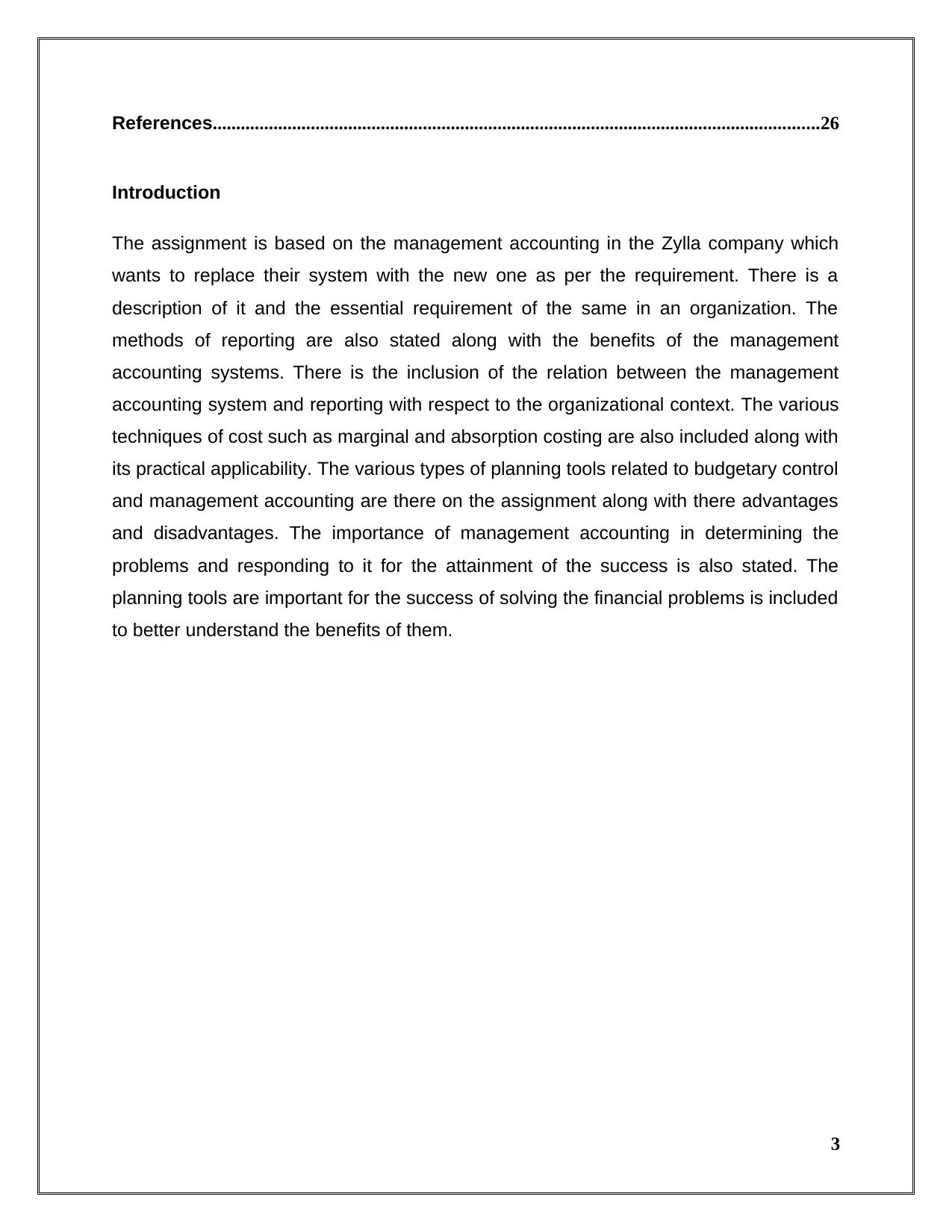
References..................................................................................................................................26
Introduction
The assignment is based on the management accounting in the Zylla company which
wants to replace their system with the new one as per the requirement. There is a
description of it and the essential requirement of the same in an organization. The
methods of reporting are also stated along with the benefits of the management
accounting systems. There is the inclusion of the relation between the management
accounting system and reporting with respect to the organizational context. The various
techniques of cost such as marginal and absorption costing are also included along with
its practical applicability. The various types of planning tools related to budgetary control
and management accounting are there on the assignment along with there advantages
and disadvantages. The importance of management accounting in determining the
problems and responding to it for the attainment of the success is also stated. The
planning tools are important for the success of solving the financial problems is included
to better understand the benefits of them.
3
Introduction
The assignment is based on the management accounting in the Zylla company which
wants to replace their system with the new one as per the requirement. There is a
description of it and the essential requirement of the same in an organization. The
methods of reporting are also stated along with the benefits of the management
accounting systems. There is the inclusion of the relation between the management
accounting system and reporting with respect to the organizational context. The various
techniques of cost such as marginal and absorption costing are also included along with
its practical applicability. The various types of planning tools related to budgetary control
and management accounting are there on the assignment along with there advantages
and disadvantages. The importance of management accounting in determining the
problems and responding to it for the attainment of the success is also stated. The
planning tools are important for the success of solving the financial problems is included
to better understand the benefits of them.
3
⊘ This is a preview!⊘
Do you want full access?
Subscribe today to unlock all pages.

Trusted by 1+ million students worldwide
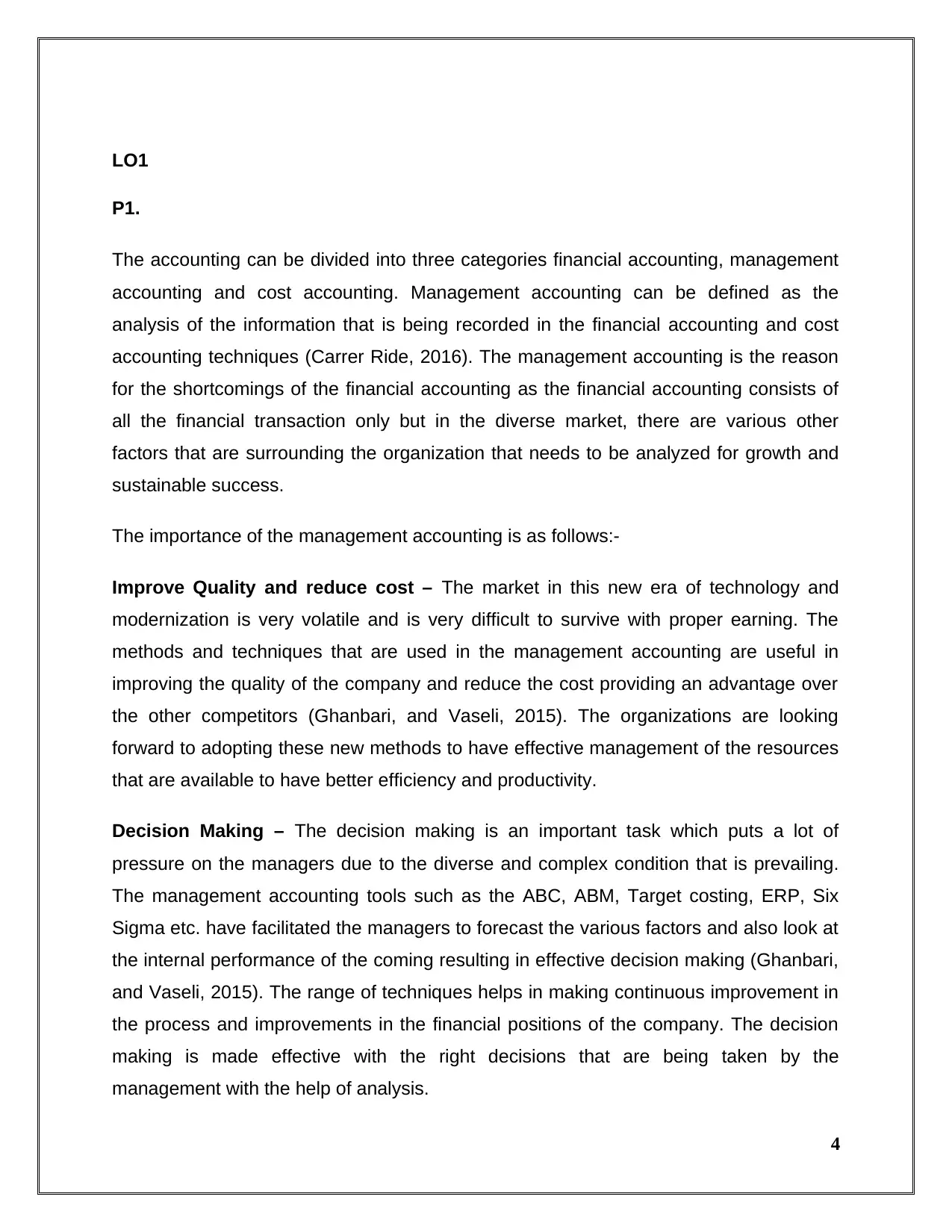
LO1
P1.
The accounting can be divided into three categories financial accounting, management
accounting and cost accounting. Management accounting can be defined as the
analysis of the information that is being recorded in the financial accounting and cost
accounting techniques (Carrer Ride, 2016). The management accounting is the reason
for the shortcomings of the financial accounting as the financial accounting consists of
all the financial transaction only but in the diverse market, there are various other
factors that are surrounding the organization that needs to be analyzed for growth and
sustainable success.
The importance of the management accounting is as follows:-
Improve Quality and reduce cost – The market in this new era of technology and
modernization is very volatile and is very difficult to survive with proper earning. The
methods and techniques that are used in the management accounting are useful in
improving the quality of the company and reduce the cost providing an advantage over
the other competitors (Ghanbari, and Vaseli, 2015). The organizations are looking
forward to adopting these new methods to have effective management of the resources
that are available to have better efficiency and productivity.
Decision Making – The decision making is an important task which puts a lot of
pressure on the managers due to the diverse and complex condition that is prevailing.
The management accounting tools such as the ABC, ABM, Target costing, ERP, Six
Sigma etc. have facilitated the managers to forecast the various factors and also look at
the internal performance of the coming resulting in effective decision making (Ghanbari,
and Vaseli, 2015). The range of techniques helps in making continuous improvement in
the process and improvements in the financial positions of the company. The decision
making is made effective with the right decisions that are being taken by the
management with the help of analysis.
4
P1.
The accounting can be divided into three categories financial accounting, management
accounting and cost accounting. Management accounting can be defined as the
analysis of the information that is being recorded in the financial accounting and cost
accounting techniques (Carrer Ride, 2016). The management accounting is the reason
for the shortcomings of the financial accounting as the financial accounting consists of
all the financial transaction only but in the diverse market, there are various other
factors that are surrounding the organization that needs to be analyzed for growth and
sustainable success.
The importance of the management accounting is as follows:-
Improve Quality and reduce cost – The market in this new era of technology and
modernization is very volatile and is very difficult to survive with proper earning. The
methods and techniques that are used in the management accounting are useful in
improving the quality of the company and reduce the cost providing an advantage over
the other competitors (Ghanbari, and Vaseli, 2015). The organizations are looking
forward to adopting these new methods to have effective management of the resources
that are available to have better efficiency and productivity.
Decision Making – The decision making is an important task which puts a lot of
pressure on the managers due to the diverse and complex condition that is prevailing.
The management accounting tools such as the ABC, ABM, Target costing, ERP, Six
Sigma etc. have facilitated the managers to forecast the various factors and also look at
the internal performance of the coming resulting in effective decision making (Ghanbari,
and Vaseli, 2015). The range of techniques helps in making continuous improvement in
the process and improvements in the financial positions of the company. The decision
making is made effective with the right decisions that are being taken by the
management with the help of analysis.
4
Paraphrase This Document
Need a fresh take? Get an instant paraphrase of this document with our AI Paraphraser
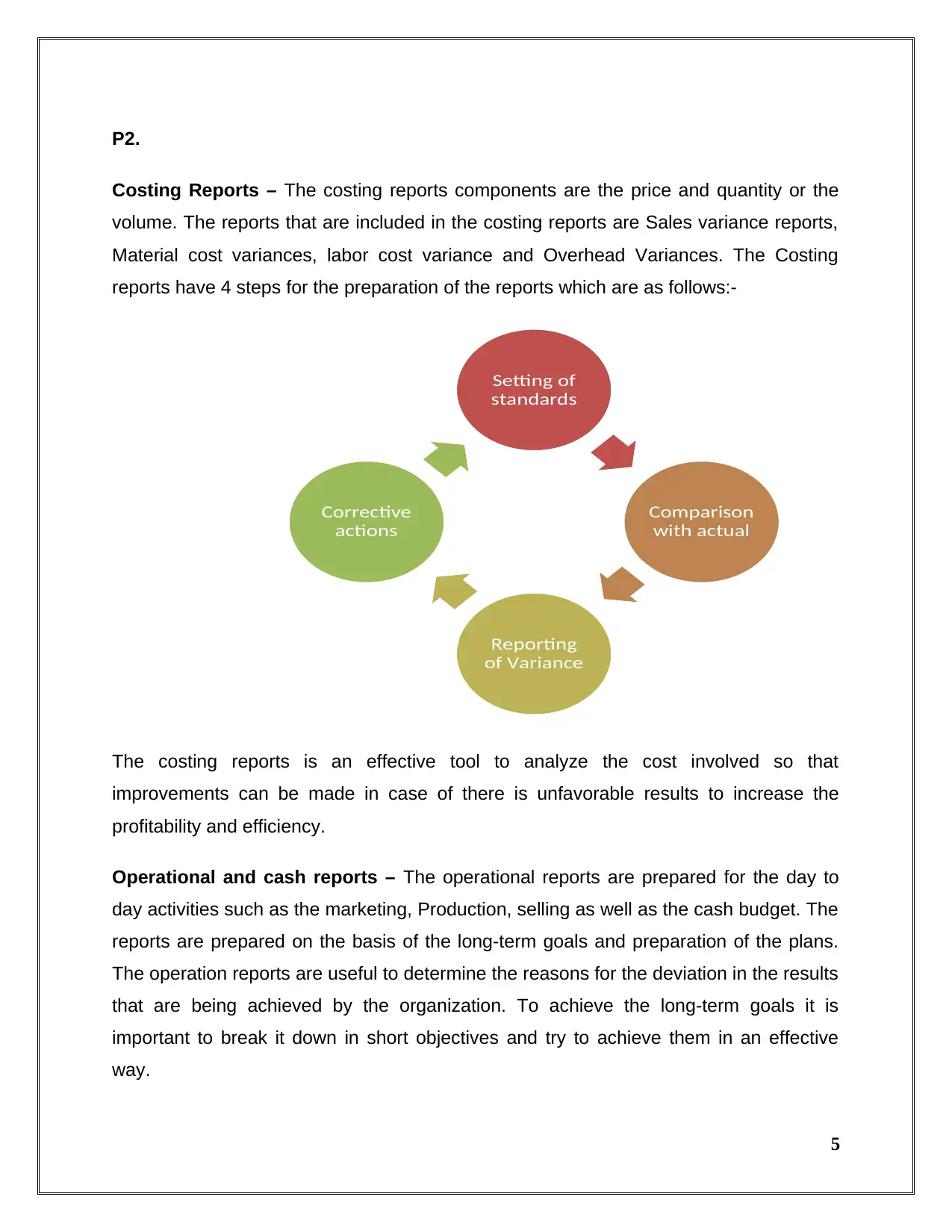
P2.
Costing Reports – The costing reports components are the price and quantity or the
volume. The reports that are included in the costing reports are Sales variance reports,
Material cost variances, labor cost variance and Overhead Variances. The Costing
reports have 4 steps for the preparation of the reports which are as follows:-
The costing reports is an effective tool to analyze the cost involved so that
improvements can be made in case of there is unfavorable results to increase the
profitability and efficiency.
Operational and cash reports – The operational reports are prepared for the day to
day activities such as the marketing, Production, selling as well as the cash budget. The
reports are prepared on the basis of the long-term goals and preparation of the plans.
The operation reports are useful to determine the reasons for the deviation in the results
that are being achieved by the organization. To achieve the long-term goals it is
important to break it down in short objectives and try to achieve them in an effective
way.
5
Setting of
standards
Comparison
with actual
Reporting
of Variance
Corrective
actions
Costing Reports – The costing reports components are the price and quantity or the
volume. The reports that are included in the costing reports are Sales variance reports,
Material cost variances, labor cost variance and Overhead Variances. The Costing
reports have 4 steps for the preparation of the reports which are as follows:-
The costing reports is an effective tool to analyze the cost involved so that
improvements can be made in case of there is unfavorable results to increase the
profitability and efficiency.
Operational and cash reports – The operational reports are prepared for the day to
day activities such as the marketing, Production, selling as well as the cash budget. The
reports are prepared on the basis of the long-term goals and preparation of the plans.
The operation reports are useful to determine the reasons for the deviation in the results
that are being achieved by the organization. To achieve the long-term goals it is
important to break it down in short objectives and try to achieve them in an effective
way.
5
Setting of
standards
Comparison
with actual
Reporting
of Variance
Corrective
actions
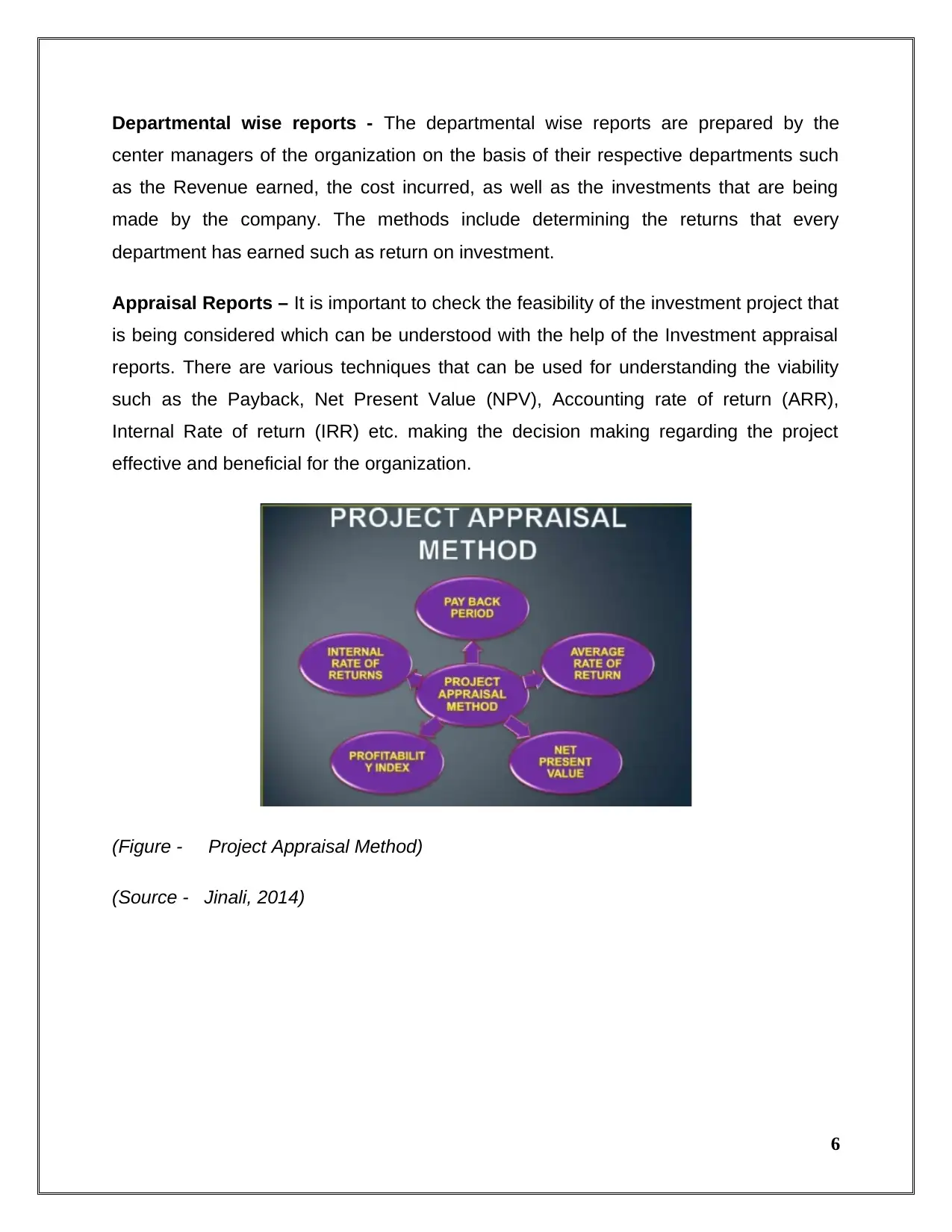
Departmental wise reports - The departmental wise reports are prepared by the
center managers of the organization on the basis of their respective departments such
as the Revenue earned, the cost incurred, as well as the investments that are being
made by the company. The methods include determining the returns that every
department has earned such as return on investment.
Appraisal Reports – It is important to check the feasibility of the investment project that
is being considered which can be understood with the help of the Investment appraisal
reports. There are various techniques that can be used for understanding the viability
such as the Payback, Net Present Value (NPV), Accounting rate of return (ARR),
Internal Rate of return (IRR) etc. making the decision making regarding the project
effective and beneficial for the organization.
(Figure - Project Appraisal Method)
(Source - Jinali, 2014)
6
center managers of the organization on the basis of their respective departments such
as the Revenue earned, the cost incurred, as well as the investments that are being
made by the company. The methods include determining the returns that every
department has earned such as return on investment.
Appraisal Reports – It is important to check the feasibility of the investment project that
is being considered which can be understood with the help of the Investment appraisal
reports. There are various techniques that can be used for understanding the viability
such as the Payback, Net Present Value (NPV), Accounting rate of return (ARR),
Internal Rate of return (IRR) etc. making the decision making regarding the project
effective and beneficial for the organization.
(Figure - Project Appraisal Method)
(Source - Jinali, 2014)
6
⊘ This is a preview!⊘
Do you want full access?
Subscribe today to unlock all pages.

Trusted by 1+ million students worldwide
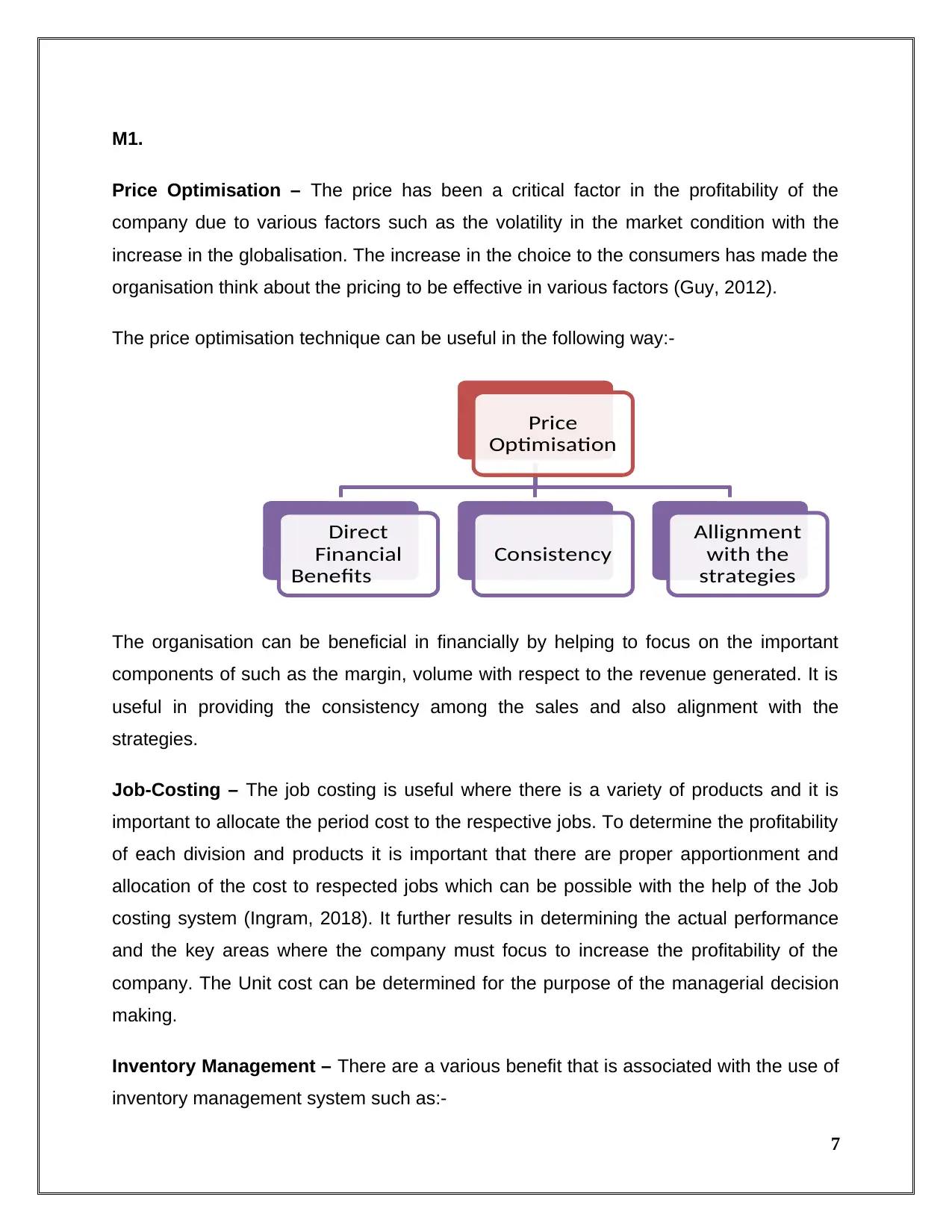
M1.
Price Optimisation – The price has been a critical factor in the profitability of the
company due to various factors such as the volatility in the market condition with the
increase in the globalisation. The increase in the choice to the consumers has made the
organisation think about the pricing to be effective in various factors (Guy, 2012).
The price optimisation technique can be useful in the following way:-
The organisation can be beneficial in financially by helping to focus on the important
components of such as the margin, volume with respect to the revenue generated. It is
useful in providing the consistency among the sales and also alignment with the
strategies.
Job-Costing – The job costing is useful where there is a variety of products and it is
important to allocate the period cost to the respective jobs. To determine the profitability
of each division and products it is important that there are proper apportionment and
allocation of the cost to respected jobs which can be possible with the help of the Job
costing system (Ingram, 2018). It further results in determining the actual performance
and the key areas where the company must focus to increase the profitability of the
company. The Unit cost can be determined for the purpose of the managerial decision
making.
Inventory Management – There are a various benefit that is associated with the use of
inventory management system such as:-
7
Price
Optimisation
Direct
Financial
Benefits
Consistency
Allignment
with the
strategies
Price Optimisation – The price has been a critical factor in the profitability of the
company due to various factors such as the volatility in the market condition with the
increase in the globalisation. The increase in the choice to the consumers has made the
organisation think about the pricing to be effective in various factors (Guy, 2012).
The price optimisation technique can be useful in the following way:-
The organisation can be beneficial in financially by helping to focus on the important
components of such as the margin, volume with respect to the revenue generated. It is
useful in providing the consistency among the sales and also alignment with the
strategies.
Job-Costing – The job costing is useful where there is a variety of products and it is
important to allocate the period cost to the respective jobs. To determine the profitability
of each division and products it is important that there are proper apportionment and
allocation of the cost to respected jobs which can be possible with the help of the Job
costing system (Ingram, 2018). It further results in determining the actual performance
and the key areas where the company must focus to increase the profitability of the
company. The Unit cost can be determined for the purpose of the managerial decision
making.
Inventory Management – There are a various benefit that is associated with the use of
inventory management system such as:-
7
Price
Optimisation
Direct
Financial
Benefits
Consistency
Allignment
with the
strategies
Paraphrase This Document
Need a fresh take? Get an instant paraphrase of this document with our AI Paraphraser
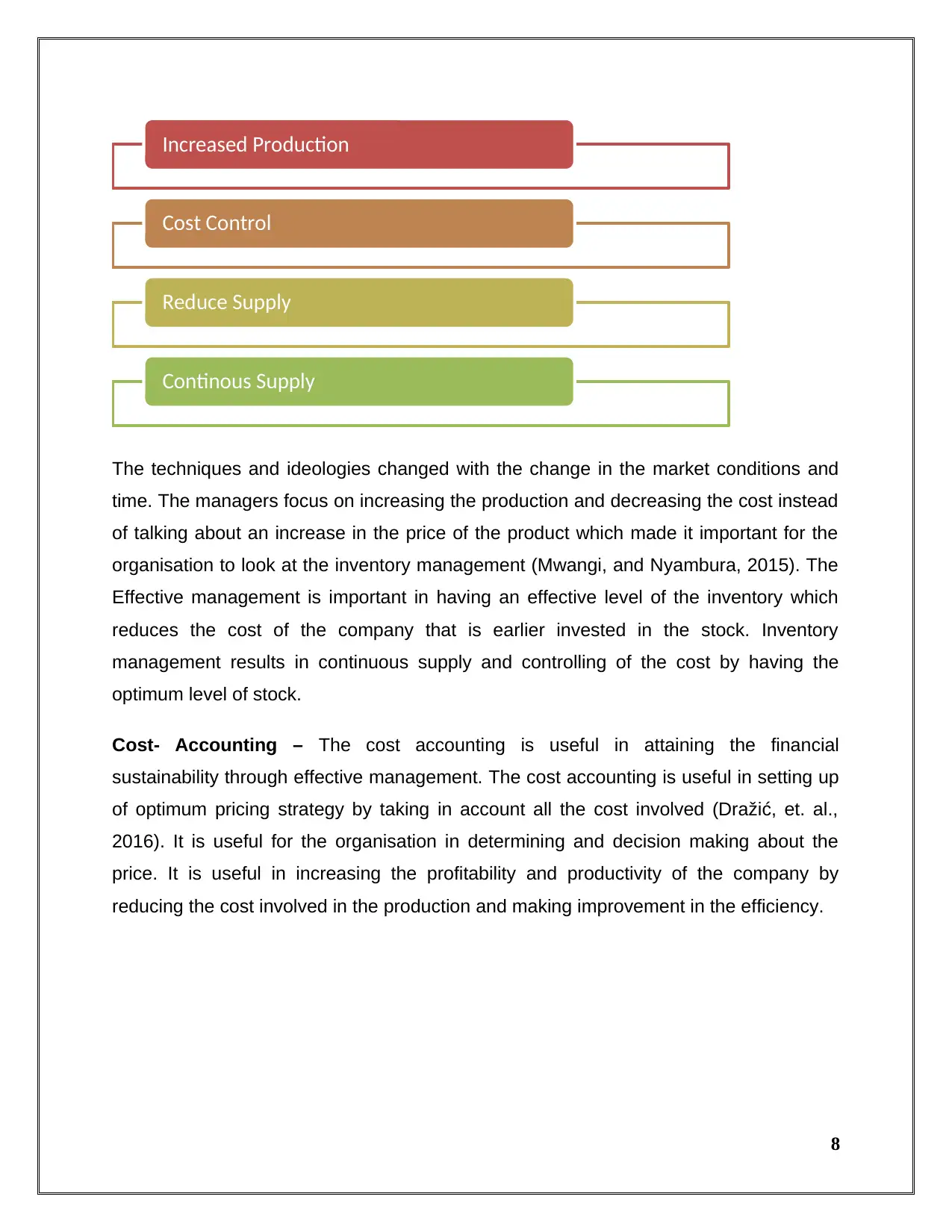
The techniques and ideologies changed with the change in the market conditions and
time. The managers focus on increasing the production and decreasing the cost instead
of talking about an increase in the price of the product which made it important for the
organisation to look at the inventory management (Mwangi, and Nyambura, 2015). The
Effective management is important in having an effective level of the inventory which
reduces the cost of the company that is earlier invested in the stock. Inventory
management results in continuous supply and controlling of the cost by having the
optimum level of stock.
Cost- Accounting – The cost accounting is useful in attaining the financial
sustainability through effective management. The cost accounting is useful in setting up
of optimum pricing strategy by taking in account all the cost involved (Dražić, et. al.,
2016). It is useful for the organisation in determining and decision making about the
price. It is useful in increasing the profitability and productivity of the company by
reducing the cost involved in the production and making improvement in the efficiency.
8
Increased Production
Cost Control
Reduce Supply
Continous Supply
time. The managers focus on increasing the production and decreasing the cost instead
of talking about an increase in the price of the product which made it important for the
organisation to look at the inventory management (Mwangi, and Nyambura, 2015). The
Effective management is important in having an effective level of the inventory which
reduces the cost of the company that is earlier invested in the stock. Inventory
management results in continuous supply and controlling of the cost by having the
optimum level of stock.
Cost- Accounting – The cost accounting is useful in attaining the financial
sustainability through effective management. The cost accounting is useful in setting up
of optimum pricing strategy by taking in account all the cost involved (Dražić, et. al.,
2016). It is useful for the organisation in determining and decision making about the
price. It is useful in increasing the profitability and productivity of the company by
reducing the cost involved in the production and making improvement in the efficiency.
8
Increased Production
Cost Control
Reduce Supply
Continous Supply
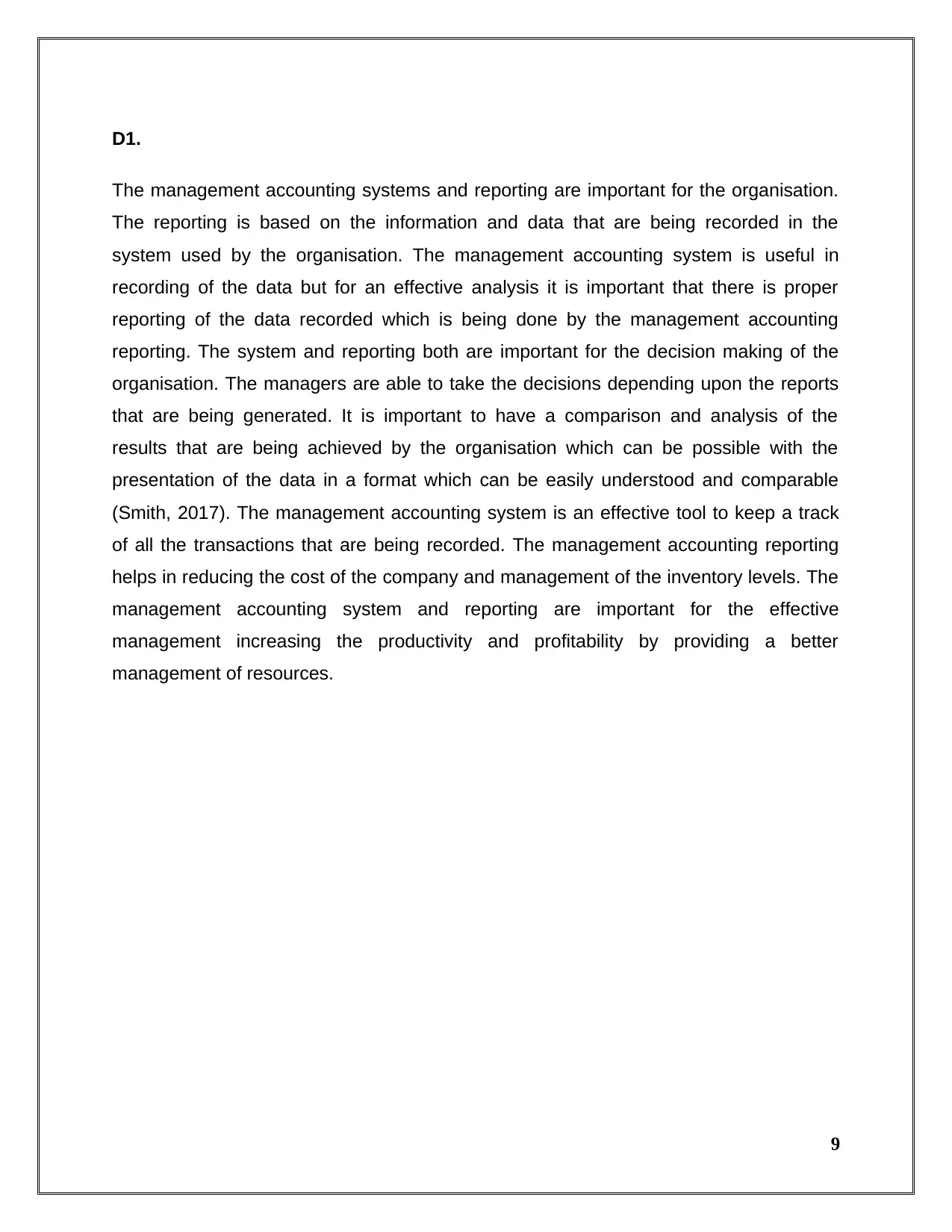
D1.
The management accounting systems and reporting are important for the organisation.
The reporting is based on the information and data that are being recorded in the
system used by the organisation. The management accounting system is useful in
recording of the data but for an effective analysis it is important that there is proper
reporting of the data recorded which is being done by the management accounting
reporting. The system and reporting both are important for the decision making of the
organisation. The managers are able to take the decisions depending upon the reports
that are being generated. It is important to have a comparison and analysis of the
results that are being achieved by the organisation which can be possible with the
presentation of the data in a format which can be easily understood and comparable
(Smith, 2017). The management accounting system is an effective tool to keep a track
of all the transactions that are being recorded. The management accounting reporting
helps in reducing the cost of the company and management of the inventory levels. The
management accounting system and reporting are important for the effective
management increasing the productivity and profitability by providing a better
management of resources.
9
The management accounting systems and reporting are important for the organisation.
The reporting is based on the information and data that are being recorded in the
system used by the organisation. The management accounting system is useful in
recording of the data but for an effective analysis it is important that there is proper
reporting of the data recorded which is being done by the management accounting
reporting. The system and reporting both are important for the decision making of the
organisation. The managers are able to take the decisions depending upon the reports
that are being generated. It is important to have a comparison and analysis of the
results that are being achieved by the organisation which can be possible with the
presentation of the data in a format which can be easily understood and comparable
(Smith, 2017). The management accounting system is an effective tool to keep a track
of all the transactions that are being recorded. The management accounting reporting
helps in reducing the cost of the company and management of the inventory levels. The
management accounting system and reporting are important for the effective
management increasing the productivity and profitability by providing a better
management of resources.
9
⊘ This is a preview!⊘
Do you want full access?
Subscribe today to unlock all pages.

Trusted by 1+ million students worldwide
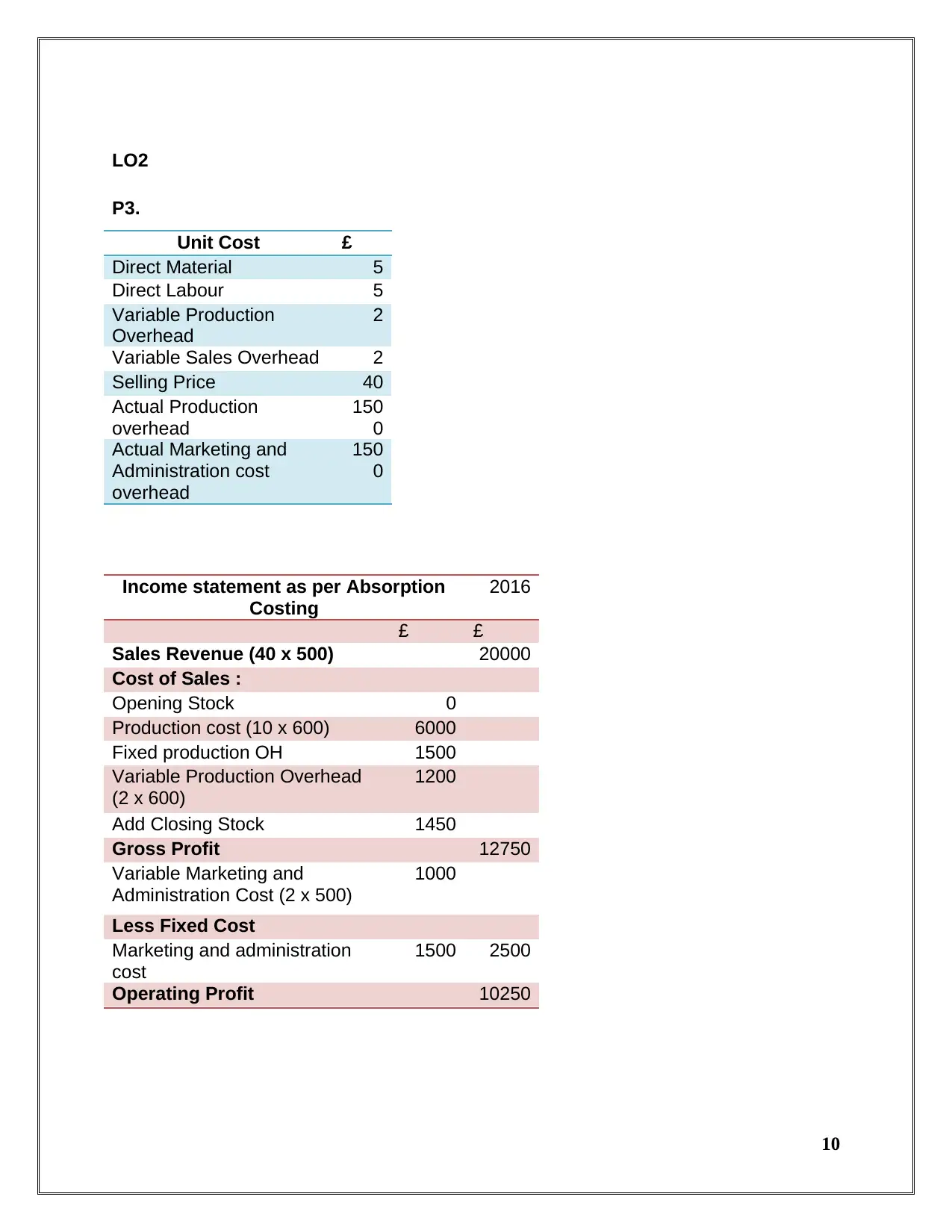
LO2
P3.
Unit Cost £
Direct Material 5
Direct Labour 5
Variable Production
Overhead
2
Variable Sales Overhead 2
Selling Price 40
Actual Production
overhead
150
0
Actual Marketing and
Administration cost
overhead
150
0
Income statement as per Absorption
Costing
2016
£ £
Sales Revenue (40 x 500) 20000
Cost of Sales :
Opening Stock 0
Production cost (10 x 600) 6000
Fixed production OH 1500
Variable Production Overhead
(2 x 600)
1200
Add Closing Stock 1450
Gross Profit 12750
Variable Marketing and
Administration Cost (2 x 500)
1000
Less Fixed Cost
Marketing and administration
cost
1500 2500
Operating Profit 10250
10
P3.
Unit Cost £
Direct Material 5
Direct Labour 5
Variable Production
Overhead
2
Variable Sales Overhead 2
Selling Price 40
Actual Production
overhead
150
0
Actual Marketing and
Administration cost
overhead
150
0
Income statement as per Absorption
Costing
2016
£ £
Sales Revenue (40 x 500) 20000
Cost of Sales :
Opening Stock 0
Production cost (10 x 600) 6000
Fixed production OH 1500
Variable Production Overhead
(2 x 600)
1200
Add Closing Stock 1450
Gross Profit 12750
Variable Marketing and
Administration Cost (2 x 500)
1000
Less Fixed Cost
Marketing and administration
cost
1500 2500
Operating Profit 10250
10
Paraphrase This Document
Need a fresh take? Get an instant paraphrase of this document with our AI Paraphraser
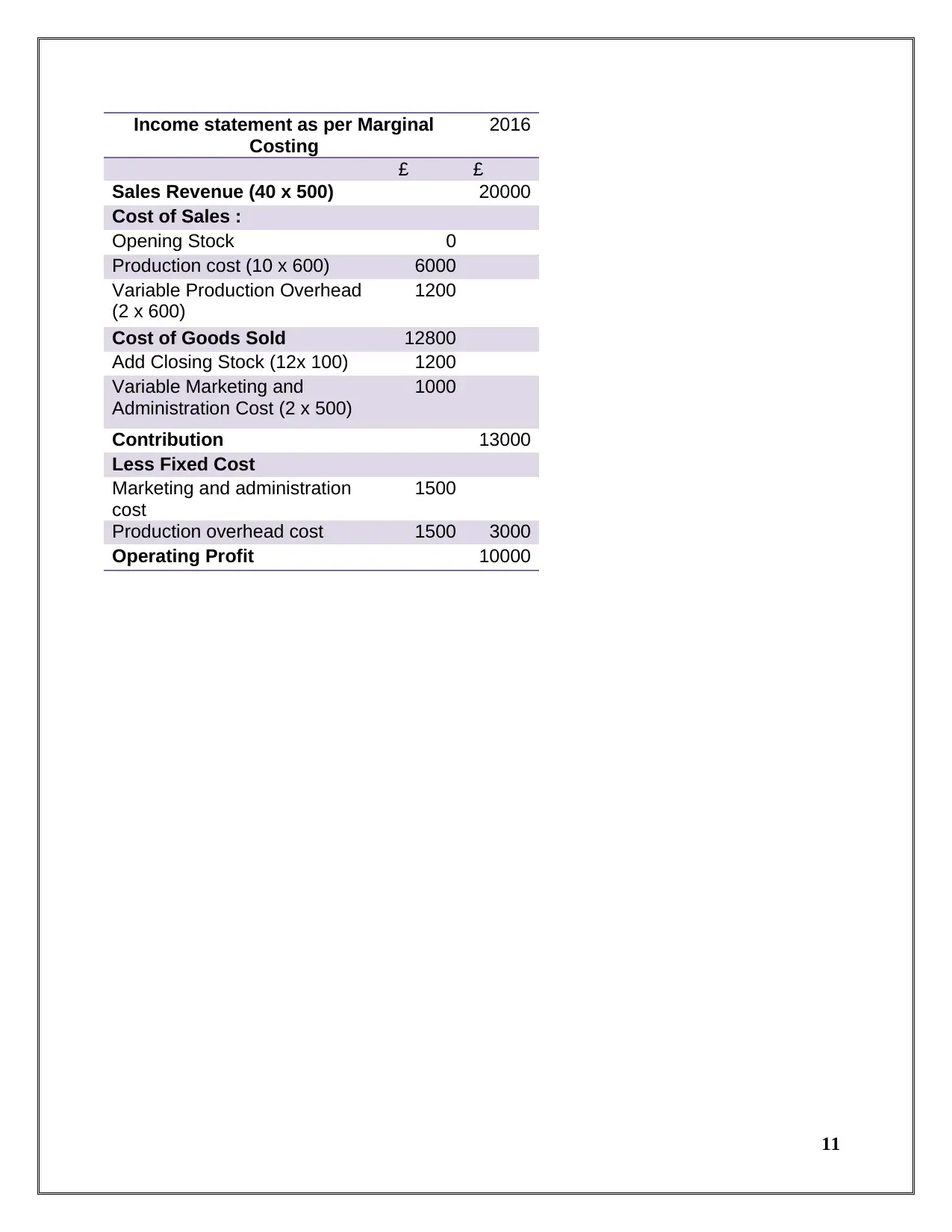
Income statement as per Marginal
Costing
2016
£ £
Sales Revenue (40 x 500) 20000
Cost of Sales :
Opening Stock 0
Production cost (10 x 600) 6000
Variable Production Overhead
(2 x 600)
1200
Cost of Goods Sold 12800
Add Closing Stock (12x 100) 1200
Variable Marketing and
Administration Cost (2 x 500)
1000
Contribution 13000
Less Fixed Cost
Marketing and administration
cost
1500
Production overhead cost 1500 3000
Operating Profit 10000
11
Costing
2016
£ £
Sales Revenue (40 x 500) 20000
Cost of Sales :
Opening Stock 0
Production cost (10 x 600) 6000
Variable Production Overhead
(2 x 600)
1200
Cost of Goods Sold 12800
Add Closing Stock (12x 100) 1200
Variable Marketing and
Administration Cost (2 x 500)
1000
Contribution 13000
Less Fixed Cost
Marketing and administration
cost
1500
Production overhead cost 1500 3000
Operating Profit 10000
11
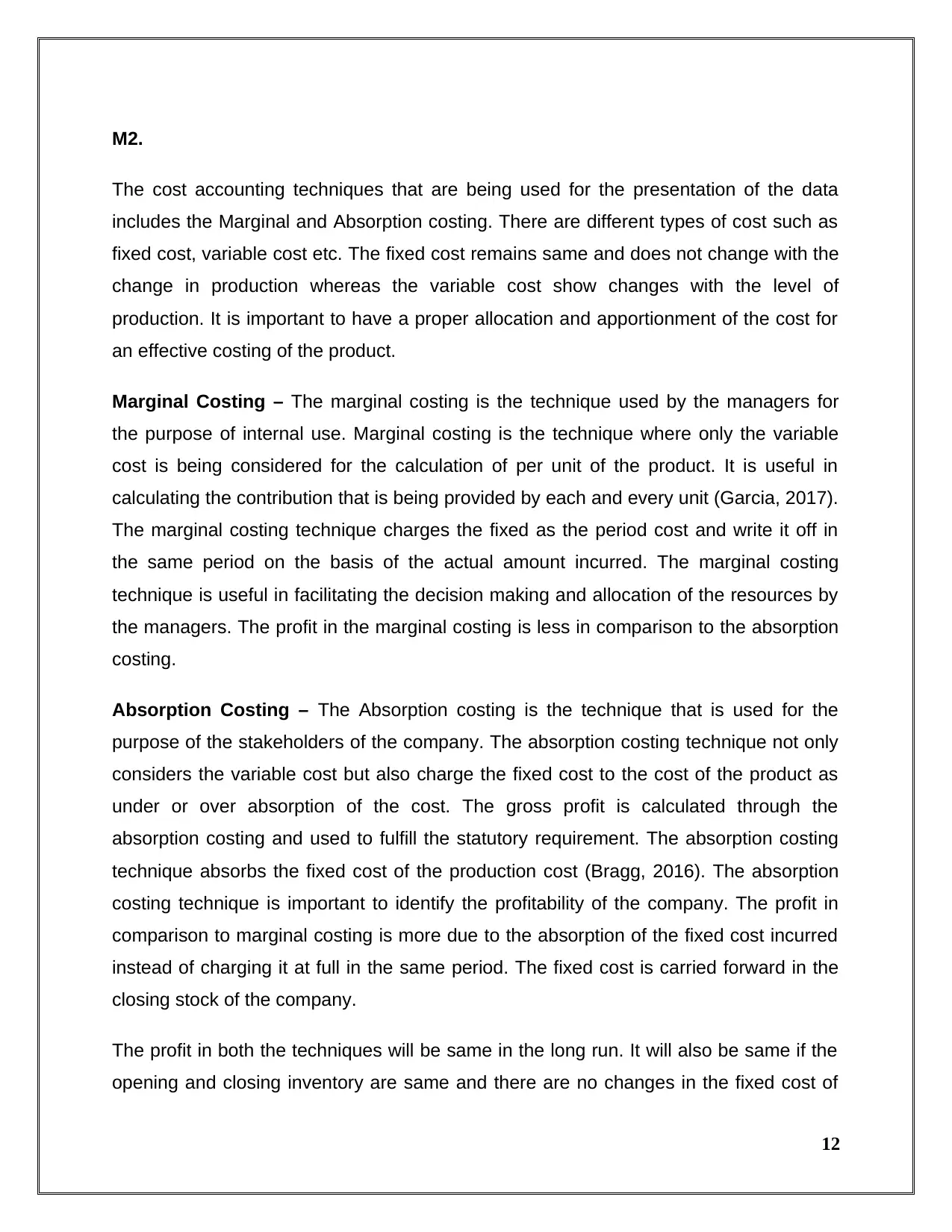
M2.
The cost accounting techniques that are being used for the presentation of the data
includes the Marginal and Absorption costing. There are different types of cost such as
fixed cost, variable cost etc. The fixed cost remains same and does not change with the
change in production whereas the variable cost show changes with the level of
production. It is important to have a proper allocation and apportionment of the cost for
an effective costing of the product.
Marginal Costing – The marginal costing is the technique used by the managers for
the purpose of internal use. Marginal costing is the technique where only the variable
cost is being considered for the calculation of per unit of the product. It is useful in
calculating the contribution that is being provided by each and every unit (Garcia, 2017).
The marginal costing technique charges the fixed as the period cost and write it off in
the same period on the basis of the actual amount incurred. The marginal costing
technique is useful in facilitating the decision making and allocation of the resources by
the managers. The profit in the marginal costing is less in comparison to the absorption
costing.
Absorption Costing – The Absorption costing is the technique that is used for the
purpose of the stakeholders of the company. The absorption costing technique not only
considers the variable cost but also charge the fixed cost to the cost of the product as
under or over absorption of the cost. The gross profit is calculated through the
absorption costing and used to fulfill the statutory requirement. The absorption costing
technique absorbs the fixed cost of the production cost (Bragg, 2016). The absorption
costing technique is important to identify the profitability of the company. The profit in
comparison to marginal costing is more due to the absorption of the fixed cost incurred
instead of charging it at full in the same period. The fixed cost is carried forward in the
closing stock of the company.
The profit in both the techniques will be same in the long run. It will also be same if the
opening and closing inventory are same and there are no changes in the fixed cost of
12
The cost accounting techniques that are being used for the presentation of the data
includes the Marginal and Absorption costing. There are different types of cost such as
fixed cost, variable cost etc. The fixed cost remains same and does not change with the
change in production whereas the variable cost show changes with the level of
production. It is important to have a proper allocation and apportionment of the cost for
an effective costing of the product.
Marginal Costing – The marginal costing is the technique used by the managers for
the purpose of internal use. Marginal costing is the technique where only the variable
cost is being considered for the calculation of per unit of the product. It is useful in
calculating the contribution that is being provided by each and every unit (Garcia, 2017).
The marginal costing technique charges the fixed as the period cost and write it off in
the same period on the basis of the actual amount incurred. The marginal costing
technique is useful in facilitating the decision making and allocation of the resources by
the managers. The profit in the marginal costing is less in comparison to the absorption
costing.
Absorption Costing – The Absorption costing is the technique that is used for the
purpose of the stakeholders of the company. The absorption costing technique not only
considers the variable cost but also charge the fixed cost to the cost of the product as
under or over absorption of the cost. The gross profit is calculated through the
absorption costing and used to fulfill the statutory requirement. The absorption costing
technique absorbs the fixed cost of the production cost (Bragg, 2016). The absorption
costing technique is important to identify the profitability of the company. The profit in
comparison to marginal costing is more due to the absorption of the fixed cost incurred
instead of charging it at full in the same period. The fixed cost is carried forward in the
closing stock of the company.
The profit in both the techniques will be same in the long run. It will also be same if the
opening and closing inventory are same and there are no changes in the fixed cost of
12
⊘ This is a preview!⊘
Do you want full access?
Subscribe today to unlock all pages.

Trusted by 1+ million students worldwide
1 out of 27
Related Documents
Your All-in-One AI-Powered Toolkit for Academic Success.
+13062052269
info@desklib.com
Available 24*7 on WhatsApp / Email
![[object Object]](/_next/static/media/star-bottom.7253800d.svg)
Unlock your academic potential
Copyright © 2020–2025 A2Z Services. All Rights Reserved. Developed and managed by ZUCOL.





